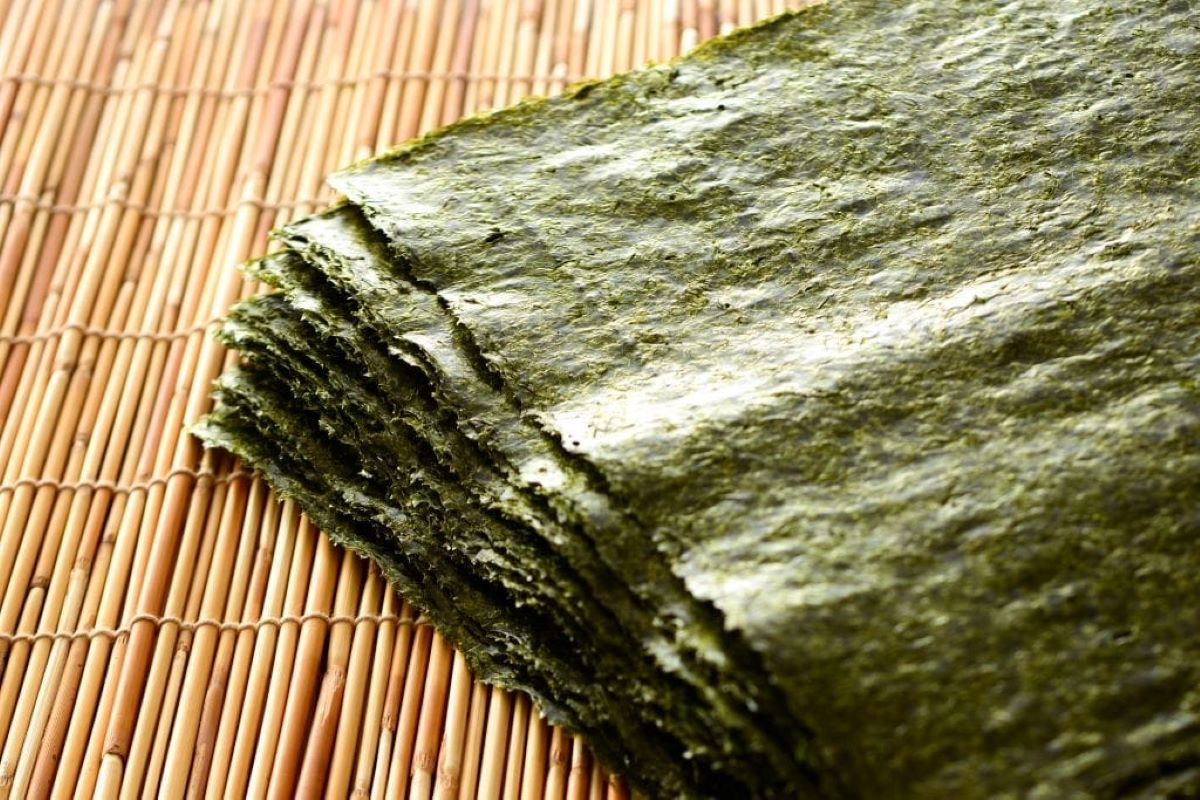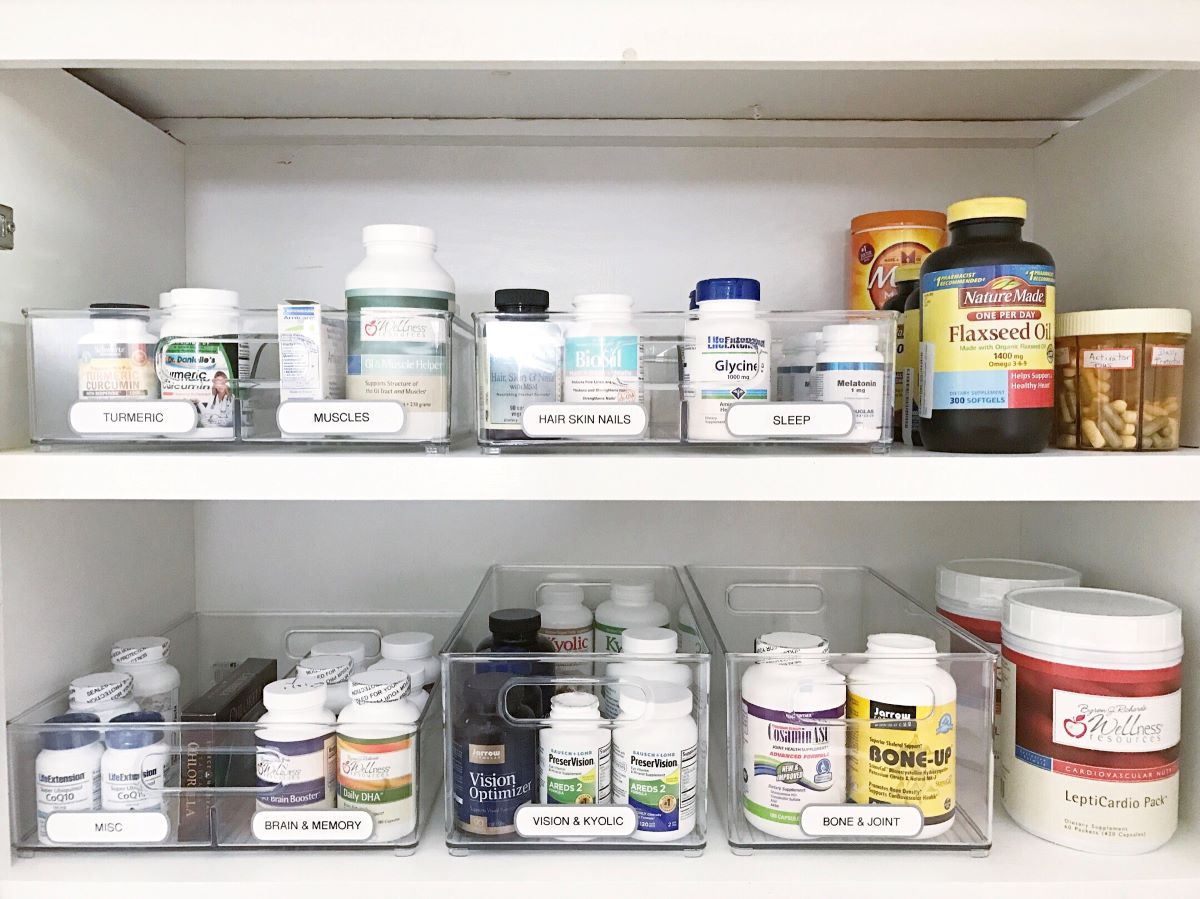

Articles
How To Store Nori
Modified: December 7, 2023
Discover the best way to store nori with our informative and helpful articles. Keep your nori fresh and flavorful for longer with these tips and techniques.
(Many of the links in this article redirect to a specific reviewed product. Your purchase of these products through affiliate links helps to generate commission for Storables.com, at no extra cost. Learn more)
Introduction
When it comes to Japanese cuisine, nori is an essential ingredient that adds a unique and savory flavor to various dishes. Whether you’re making sushi rolls, miso soup, or even crispy snacks, fresh and high-quality nori can elevate your culinary creations to new heights. However, to fully enjoy the taste and texture of nori, it is crucial to store it properly and preserve its freshness.
Properly storing nori not only ensures that it retains its flavor but also helps to maintain its nutritional value. Nori is packed with essential nutrients like vitamins, minerals, and antioxidants, which offer numerous health benefits. By storing nori correctly, you can prolong its shelf life and enjoy its delicate flavor for an extended period.
In this article, we will explore the ins and outs of storing nori, including the factors that affect its storage, choosing the right storage container, preparing nori for storage, ideal storage temperature, avoiding moisture and humidity, protecting it from direct sunlight, determining the ideal length of storage, recognizing signs of spoiled nori, and tips for extending its shelf life. Let’s delve into the details and discover how to keep your nori fresh and flavorful!
Key Takeaways:
- Properly storing nori is crucial to maintain its freshness, flavor, and nutritional value. Consider factors like air exposure, moisture, and temperature to ensure optimal storage conditions.
- Choose airtight, food-safe containers, and store nori in a cool, dry place away from direct sunlight. Follow simple preparation steps and be mindful of signs of spoilage to enjoy fresh nori for an extended period.
Read more: How To Store Nori Sheets
Importance of Properly Storing Nori
Properly storing nori is crucial in order to maintain its freshness, flavor, and nutritional value. Here’s why it is important:
- Freshness: Nori is at its best when it is fresh. Storing it properly helps to prevent it from becoming stale, which can result in a loss of flavor and texture. Fresh nori enhances the overall taste of your meals and provides a delightful eating experience.
- Flavor: Nori has a delicate and distinct flavor that can easily be affected by improper storage. Exposure to air, moisture, or heat can cause the nori to lose its flavor and become bland. By storing nori correctly, you can preserve that umami taste and ensure that each bite is bursting with flavor.
- Nutritional Value: Nori is a nutrient-dense food that offers a range of health benefits. It is rich in vitamins, minerals, and antioxidants, including vitamin C, calcium, and iodine. Proper storage helps to retain these valuable nutrients, ensuring that you receive their full nutritional benefits when consuming nori.
- Cost-effectiveness: By storing nori properly, you can avoid wastage and save money. If nori is not stored correctly, it can become spoiled or lose its quality, resulting in the need to discard it. Proper storage techniques help to extend the shelf life of nori, allowing you to use it for a more extended period and get the most out of your purchase.
Overall, properly storing nori is essential to maintain its freshness, flavor, nutritional value, and your investment. The next sections will guide you through the factors that affect nori storage and provide valuable tips on how to store it correctly.
Factors Affecting Nori Storage
Several factors can impact the storage of nori, including:
- Air Exposure: Exposure to air can lead to the oxidation of nori, causing it to become stale and lose its flavor. It is essential to minimize air exposure by properly sealing the nori packaging or transferring it to an airtight container.
- Moisture and Humidity: Nori is highly sensitive to moisture and humidity. Excessive moisture can cause nori to become damp, resulting in a loss of crispness and flavor. It can also promote the growth of mold and bacteria. Maintaining a dry environment and protecting nori from moisture are vital for its long-term storage.
- Heat and Temperature: Nori should be stored at an ideal temperature to prevent it from becoming brittle or losing its taste. High temperatures can also lead to the degradation of its nutritional value. It is recommended to store nori in a cool and dry place, away from direct heat sources.
- Light Exposure: Like many food products, nori is susceptible to light exposure. Ultraviolet (UV) radiation from sunlight can cause essential compounds in nori to break down, resulting in a degradation of flavor and quality. Therefore, it is crucial to store nori in a dark or opaque container and avoid exposing it to direct sunlight.
- Container Choice: The choice of storage container can also affect the shelf life of nori. It is recommended to use airtight containers made of materials that are food-safe and can block light. Glass jars or resealable plastic bags can be great options for storing nori.
By considering these factors and implementing appropriate storage measures, you can ensure that your nori stays fresh, flavorful, and in optimal condition. The next section will provide guidance on choosing the right storage container for storing nori.
Choosing the Right Storage Container
The choice of a proper storage container is essential to maintain the freshness and quality of nori. Here are some factors to consider when selecting a storage container:
- Airtight Seal: Look for a container that has an airtight seal. This will prevent air from entering the container and causing the nori to become stale. An airtight seal also helps in keeping moisture and humidity out, preserving the crispness and flavor of the nori.
- Material: Opt for a container made of food-safe materials. Glass jars and food-grade plastic containers are excellent options for storing nori. They are non-reactive and won’t transfer any unwanted flavors or odors to the nori.
- Opaque or Dark Color: Nori is sensitive to light, especially UV radiation from sunlight. Choosing a container that is opaque or of a dark color will help to protect the nori from light exposure and prevent degradation of its flavor and quality.
- Size: Consider the size of the container based on the quantity of nori you plan to store. It should be spacious enough to accommodate the nori sheets without causing them to fold or bend excessively.
- Easy to Use and Clean: Look for a container that is easy to open and close. This will make it convenient to access the nori whenever needed. Additionally, choose a container that is easy to clean to maintain hygiene.
Remember to thoroughly clean and dry the container before storing nori to prevent contamination or moisture buildup. Once you have chosen the appropriate storage container, the next step is to prepare the nori for storage, which will be discussed in the following section.
Preparing Nori for Storage
Before storing nori, it is essential to prepare it properly to ensure maximum freshness and longevity. Here are some steps to follow when preparing nori for storage:
- Inspect the Nori: Check the nori sheets for any signs of damage, such as tears or discoloration. Remove any damaged or spoiled sheets to prevent them from affecting the quality of the rest of the nori.
- Divide into Portions: If you have a large package of nori, consider dividing it into smaller portions. This will help you to only open and access the amount of nori you need at a time, reducing the exposure of the remaining sheets to air and moisture.
- Use Airtight Packaging: If the nori came in a resealable package, make sure to seal it tightly after each use. Alternatively, transfer the nori into airtight containers or resealable bags. Press out any excess air before sealing to minimize air exposure.
- Label and Date: To keep track of the storage time and ensure you use the nori before it loses its freshness, label the package or container with the date of storage. This will help you to prioritize the use of older nori and maintain its quality.
By following these simple preparation steps, you can ensure that your nori is well-preserved and ready for storage. The next sections will discuss the ideal storage temperature, ways to avoid moisture and humidity, and the importance of keeping nori away from direct sunlight.
Read more: How To Store Basil From Store
Proper Storage Temperature
The ideal storage temperature for nori is cool and dry. Extreme temperatures can negatively impact the quality and flavor of the nori, so it is important to store it within a suitable temperature range. Here are some guidelines to keep in mind:
- Cool Temperature: Nori should be stored in a cool environment to maintain its texture and taste. Room temperature is generally acceptable, but if possible, storing it in a slightly cooler location can help to preserve its freshness for a longer period. Avoid storing nori in areas that are too hot or where temperatures fluctuate frequently, such as near ovens or stoves.
- Avoid Freezing: While nori can technically be frozen, it is generally not recommended as it can affect the texture and crispness of the sheets. Freezing can cause moisture to build up and make the nori soggy when thawed. It is best to keep nori in a cool pantry or cupboard rather than the freezer.
- Refrigeration Considerations: It is not necessary to refrigerate nori unless you live in a particularly hot and humid climate. However, if you choose to refrigerate it, ensure that it is stored in an airtight container to prevent moisture absorption and odor transfer from other foods in the refrigerator.
By storing nori at an appropriate temperature, you can preserve its flavor, crispness, and quality for an extended period. However, it is equally important to protect it from moisture and humidity, as mentioned in the following section.
Store nori in a cool, dry place away from direct sunlight and moisture. A resealable bag or airtight container will help maintain its freshness. Avoid storing it in the refrigerator, as the moisture can cause it to become soggy.
Avoiding Moisture and Humidity
Moisture and humidity are major enemies when it comes to storing nori. Excessive moisture can cause nori to become damp, lose its crispness, and become more vulnerable to mold and bacteria growth. To avoid moisture and humidity-related issues, consider the following tips:
- Use Desiccant Packs: Desiccant packs help absorb excess moisture and maintain a dry environment. Place a desiccant pack inside the container or bag with the nori to prevent moisture buildup.
- Avoid Storing in the Refrigerator Door: The refrigerator door is prone to temperature fluctuations and higher humidity levels. Instead, opt to store nori in the main compartment of the refrigerator or in a cool, dry pantry away from sources of moisture like sinks or dishwashers.
- Keep Packaging Intact: If you are storing nori in its original packaging, ensure that it remains intact. The packaging acts as a barrier against moisture and helps to maintain its quality. If the package is damaged, transfer the nori to an airtight container or resealable bag.
- Reseal Properly: Whether you are using the original packaging or an airtight container, ensure that it is sealed tightly after each use to prevent moisture from entering. Press out any excess air before sealing to minimize air exposure as well.
- Avoid Storing Near the Stove or Sink: Heat and moisture from cooking or washing dishes can introduce unwanted humidity into the storage area. Keep nori stored away from the stove or sink to avoid exposure to these moisture sources.
By taking precautions to avoid moisture and humidity, you can prolong the shelf life of nori and maintain its crispness and quality. When it comes to the storage of nori, protecting it from direct sunlight is equally important, as discussed in the next section.
Keeping Nori Away from Direct Sunlight
Direct sunlight can have detrimental effects on the quality and flavor of nori. Exposure to sunlight can cause the delicate nori sheets to become brittle, lose their vibrant color, and experience flavor degradation. To protect nori from direct sunlight, consider the following measures:
- Store in a Dark or Opaque Container: Choose a storage container that is dark or opaque to shield the nori from sunlight. This will help prevent the harmful UV rays from penetrating the container and deteriorating the quality of the nori.
- Select a Suitable Storage Location: Find a storage location that is away from direct sunlight. Ideally, pick a cool and dry area of your pantry or a cupboard that does not receive direct sunlight throughout the day.
- Avoid Displaying Near Windows: Avoid placing nori containers near windows, as sunlight exposure can be intense and prolonged, especially during peak daylight hours. This will help prevent any incidental exposure to sunlight.
- Consider an Extra Layer of Protection: If your chosen storage location is not completely shielded from sunlight, consider placing the nori container inside a drawer or wrapping it in an additional layer of dark or opaque material, like a kitchen towel or aluminum foil.
By taking these precautions to keep nori away from direct sunlight, you can maintain its color, flavor, and overall quality. However, it is also important to be mindful of the length of time nori is stored. The following section will discuss the ideal length of nori storage to ensure optimal freshness.
Length of Nori Storage
Nori is best enjoyed when it is fresh. While it does have a relatively long shelf life, it is recommended to consume nori within a certain timeframe to ensure optimal freshness and quality. The exact length of storage can vary depending on factors such as the packaging, storage conditions, and individual preferences. Here are some general guidelines:
- Unopened Nori: If the nori is still sealed in its original packaging and has not been opened, it can typically be stored for up to one year. However, it is advisable to check the expiration date on the packaging and consume it before that date for the best flavor.
- Opened Nori: Once the nori package has been opened, it is best to use it within a few weeks to maintain its freshness and flavor. A good practice is to consume the opened nori within one to two months, although it can still be safe to eat for a slightly longer period if stored properly.
- Refrigerated Nori: If you prefer to refrigerate your nori, it can extend its shelf life by a few additional months. However, be mindful that refrigeration may affect the texture and crispness of the nori sheets. It is recommended to use refrigerated nori within three to four months to ensure the best taste and quality.
- Quality Check: Regardless of the storage duration, it is crucial to perform a visual and sensory quality check before using nori. Discard nori that displays signs of mold, an off-color appearance, or a rancid smell. Fresh nori should have a vibrant green color, a crisp texture, and a pleasant, seaweed-like aroma.
Keep in mind that these are general guidelines, and it is always best to use your judgment and adhere to any guidelines provided by the manufacturer. By consuming nori within the suggested timeframes, you can ensure that it retains its freshness and delivers the best flavor and overall experience.
Now that we’ve covered the length of nori storage, let’s move on to the signs of spoiled nori in the next section.
Read more: How To Store Store-Bought Bread
Signs of Spoiled Nori
It is important to be aware of the signs of spoiled nori to avoid consuming it when it is no longer safe or enjoyable. Here are some common indications that nori has gone bad:
- Off-color Appearance: Fresh nori typically has a vibrant green color. If you notice any discoloration, such as brown spots or a faded appearance, it may indicate that the nori has started to spoil.
- Mold Growth: One of the most obvious signs of spoiled nori is the presence of mold. If you see any fuzzy, discolored patches or spots on the nori sheets, it is best to discard them immediately. Mold can pose health risks when consumed.
- Dampness or Softness: Nori sheets are meant to be crisp and dry. If you find that the nori feels damp, soft, or limp to the touch, it may indicate that moisture has penetrated the packaging or storage container. This can lead to a loss of texture and quality.
- Unpleasant Odor: Nori should have a distinctive seaweed-like aroma. If you notice a foul or rancid smell, it is a clear indication that the nori has spoiled and is no longer suitable for consumption.
- Taste: Lastly, if you notice an off or unpleasant taste when consuming nori, it may indicate that it has gone bad. Fresh nori should have a subtly sweet and oceanic flavor. If the taste is bitter, sour, or otherwise unpalatable, it is best to stop consuming it.
If you observe any of these signs, it is recommended to discard the nori immediately. Consuming spoiled nori can lead to foodborne illnesses and a negative culinary experience. It’s better to be safe than sorry.
Now that we are aware of the signs of spoiled nori, let’s explore some tips for extending its shelf life in the next section.
Tips for Extending Nori Shelf Life
To extend the shelf life of nori and preserve its freshness, flavor, and quality, consider the following tips:
- Proper Storage: Store nori in a cool, dry place away from direct sunlight, heat sources, and moisture. Choose airtight containers or resealable bags to minimize air exposure.
- Portion Control: Divide larger packages of nori into smaller portions to minimize the frequency of opening and resealing, reducing air exposure and potential moisture absorption.
- Use Desiccant Packs: Place desiccant packs in the nori packaging or storage container to absorb excess moisture and maintain a dry environment.
- Seal Properly: Ensure that the packaging or storage container is tightly sealed after each use to prevent air, moisture, and odors from compromising the nori’s quality.
- Label and Rotate: Label the nori packaging or container with the date of storage and use older nori first to ensure that it is consumed before its freshness deteriorates.
- Avoid Excessive Handling: Excessively handling nori can introduce moisture, so handle it with clean, dry hands and use utensils whenever possible.
- Consume Opened Nori Promptly: Once a package of nori has been opened, aim to consume it within a few weeks to maintain its freshness. Consider using it in various recipes or snacks to make the most of it.
- Choose High-Quality Nori: Opt for nori sheets of good quality from reputable brands. High-quality nori tends to have a longer shelf life due to proper processing and packaging.
- Keep Nori Dry: If you live in a humid environment, you can store nori along with a food-grade silica gel packet to help absorb moisture and prevent it from becoming damp.
By following these tips, you can extend the shelf life of nori and ensure that it remains fresh, flavorful, and enjoyable for a longer period. However, it is always essential to inspect nori visually and consider its aroma and taste before consuming it, as freshness may still vary based on storage conditions and individual factors.
Now that you are equipped with the knowledge of extending nori’s shelf life, let’s conclude our exploration of proper nori storage.
Conclusion
Properly storing nori is vital to maintain its freshness, flavor, and nutritional value. By taking simple steps to store nori correctly, you can extend its shelf life and ensure that each bite is a delight. Here are the key points to remember:
Firstly, pay attention to the factors that affect nori storage, such as air exposure, moisture and humidity, heat, light exposure, and the choice of storage container. By considering these factors, you can keep your nori in optimal condition.
Choose a suitable storage container that is airtight, made of food-safe materials, and opaque or dark in color to protect nori from air, light, and moisture. Properly prepare nori for storage by inspecting it, dividing it into portions, and using airtight packaging.
Store nori in a cool, dry place away from direct sunlight, heat sources, and humidity. Avoid freezing nori, and refrigerate it only if necessary, ensuring it is properly sealed to prevent moisture absorption.
Recognize the signs of spoiled nori, such as off-color appearance, mold growth, dampness, unpleasant odor, or an altered taste. If you notice any of these signs, it is best to discard the nori.
Lastly, follow tips for extending nori’s shelf life, including proper storage, portion control, using desiccant packs, sealing containers, labeling and rotating, minimizing handling, choosing high-quality nori, and keeping nori dry.
By implementing these practices, you can enjoy fresh, flavorful nori for an extended period. Remember to check the packaging for any specific storage recommendations provided by the manufacturer, and always use your senses to ensure that the nori is fresh and safe for consumption.
Now that you are equipped with knowledge on how to store nori properly, it’s time to stock up on this versatile and delicious ingredient for your next culinary adventure!
Frequently Asked Questions about How To Store Nori
Was this page helpful?
At Storables.com, we guarantee accurate and reliable information. Our content, validated by Expert Board Contributors, is crafted following stringent Editorial Policies. We're committed to providing you with well-researched, expert-backed insights for all your informational needs.














0 thoughts on “How To Store Nori”